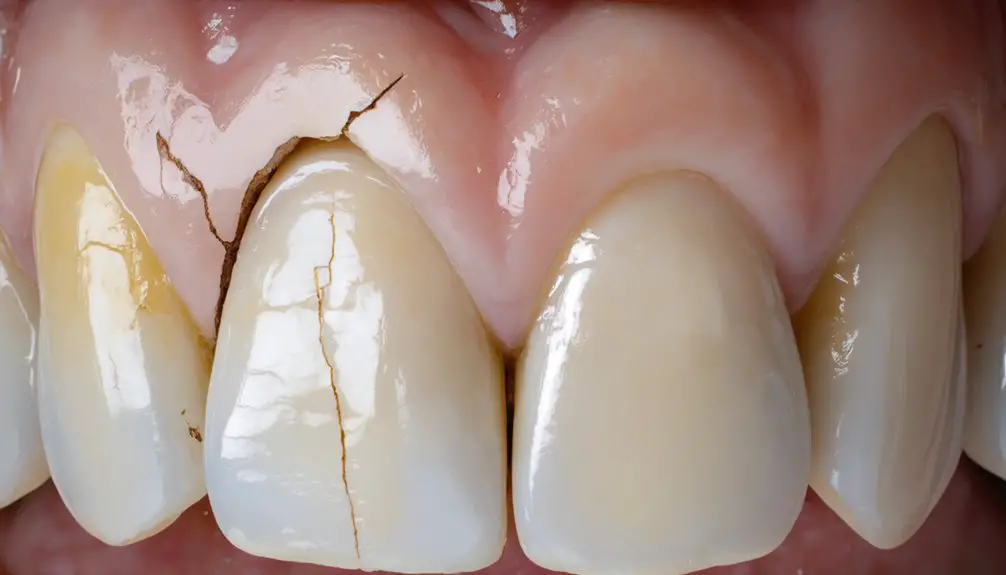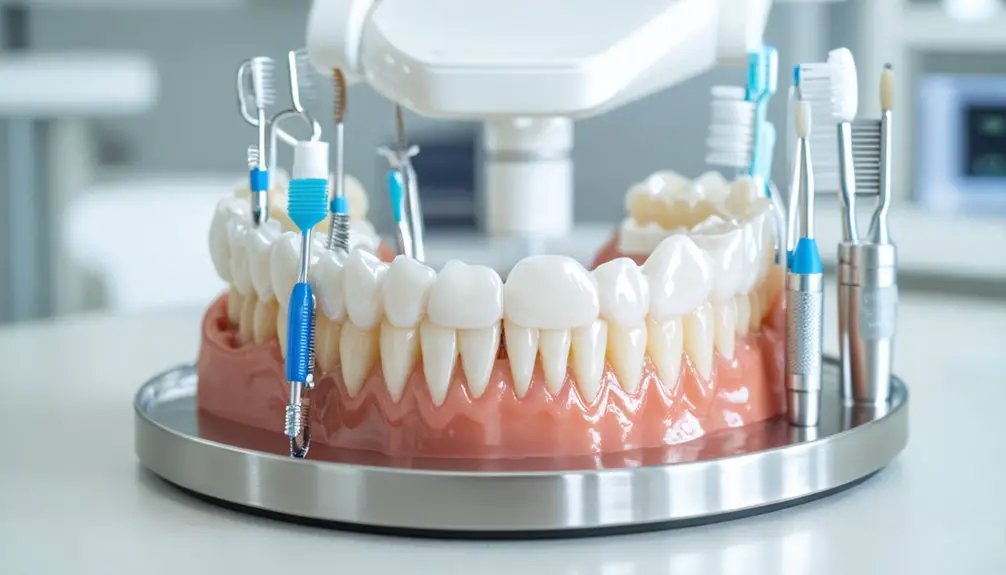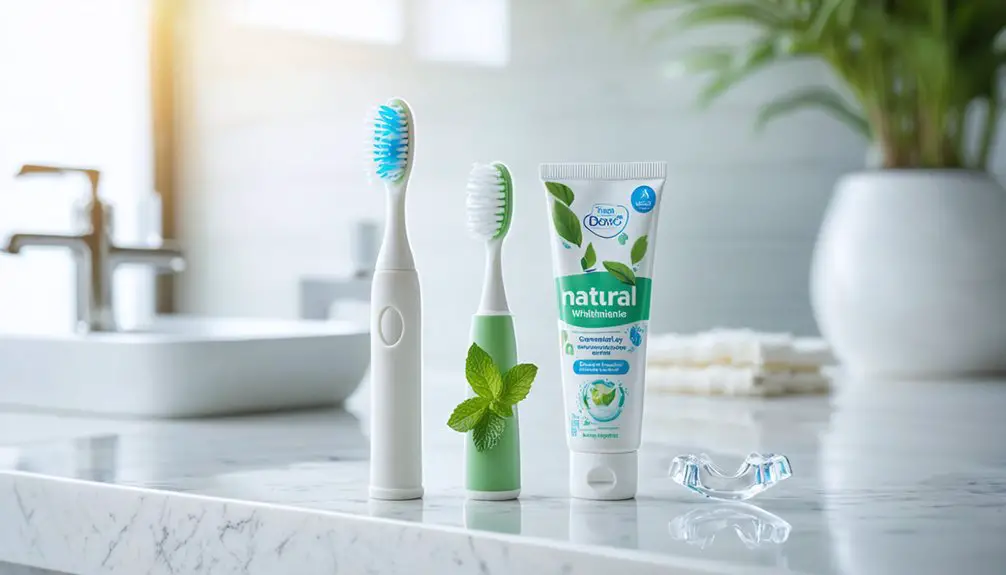If you whiten damaged teeth, you’ll face increased risks of severe sensitivity, uneven results, and potential nerve inflammation. Bleaching agents can penetrate compromised enamel more easily, leading to intense discomfort and possible long-term damage. Over 50% of patients with damaged teeth report heightened sensitivity during whitening procedures, especially with higher peroxide concentrations. Professional assessment and proper treatment planning can help minimize these significant complications.
Key Takeaways
- Damaged teeth experience heightened sensitivity to temperature and sweet stimuli during whitening, with over 50% of patients reporting increased discomfort.
- Peroxide agents can penetrate damaged enamel more easily, causing intense pain and potentially worsening existing structural weaknesses.
- Uneven whitening results are common due to irregular enamel surfaces, leading to patchy or inconsistent coloration.
- Repeated exposure to bleaching agents may cause permanent damage, especially in teeth with compromised enamel or existing cracks.
- Risks include pulpal inflammation, gum irritation, and further enamel erosion, particularly with higher peroxide concentrations of 35-40%.
Understanding Pre-Existing Dental Damage
While tooth damage can occur through various mechanisms, understanding pre-existing dental issues is essential before pursuing any whitening treatment. Your teeth may have structural weaknesses from trauma, accidents, or natural wear that affect their integrity.
Cracks, chips, and exposed dentin create irregular surfaces that facilitate bacterial colonization and plaque buildup. Pre-existing damage often extends beyond visible problems. These damaged areas can harbor Streptococcus mutans colonies that contribute to ongoing decay.
Dental imperfections like chips and cracks not only harm appearance but create hidden pathways for bacteria to thrive beneath the surface.
Systemic conditions like Parkinson’s disease or Huntington’s can worsen tooth structure through grinding or poor hygiene maintenance. Regular dental checkups are vital for detecting these issues early. If you’ve lost crowns or restorations, the underlying tooth becomes more vulnerable to sensitivity and further deterioration.
Additionally, untreated decay and infections can compromise your tooth’s strength, as bacteria penetrate deeper into damaged areas. These conditions require careful evaluation before proceeding with any whitening procedures.
Common Complications With Compromised Teeth
Although teeth whitening remains a popular cosmetic treatment, compromised teeth face significant risks during the bleaching process. When you undergo tooth whitening with damaged teeth, you’ll likely experience heightened sensitivity to hot, cold, and sweet stimuli.
The peroxide agents can penetrate deeper through compromised enamel, causing intense discomfort that may persist for days. Your damaged teeth are also more susceptible to uneven whitening results, especially if you have restorations or irregular enamel surfaces. Using desensitizing gels can help minimize discomfort during and after the whitening process. Professional supervision through in-office treatments provides safer results by implementing protective measures.
A thorough damage assessment before treatment is essential, as whitening can worsen existing problems. You’ll face increased risks of pulpal inflammation, gum irritation, and further enamel erosion.
The structural integrity of compromised teeth may deteriorate with repeated exposure to bleaching agents, potentially leading to permanent damage.
Professional Assessment Requirements
Before undergoing any tooth whitening procedure, you’ll need an extensive dental examination to evaluate the condition of your teeth and identify potential risks.
Your dentist must thoroughly assess existing damage, such as cracks, worn enamel, or exposed dentin, as these conditions can lead to increased sensitivity or complications during whitening. During this visit, protective barriers will be evaluated to determine the best way to safeguard your gums and sensitive areas.
Based on this professional evaluation, your dentist will create a detailed treatment plan that accounts for your tooth condition, determines appropriate whitening methods, and establishes necessary precautions. This evaluation includes a complete review of dental history to understand previous treatments and reactions.
Pre-Treatment Dental Examination Required
Since tooth whitening carries potential risks for damaged teeth, a meticulous pre-treatment dental examination is essential to guarantee patient safety and ideal outcomes.
Before beginning any whitening procedure, you’ll need to obtain pre-treatment consent and document a complete dental history, including previous treatments and any sensitivity issues.
Your dentist must perform extensive extraoral and intraoral examinations, checking for enamel cracks, exposed roots, and existing restorations.
They’ll take diagnostic images to detect underlying problems like decay or infections that could worsen with whitening agents.
Through clinical photography and detailed assessments, they’ll evaluate your enamel thickness and integrity.
This thorough examination helps determine if whitening is appropriate for your situation or if you’ll need alternative treatments to achieve your desired results.
Dental practitioners must personally examine patients before any whitening products can be supplied.
Understanding patient concerns is critical, as a proper evaluation of tooth discoloration etiology guides treatment decisions.
Existing Damage Impact Evaluation
When evaluating damaged teeth for whitening treatment, dental professionals must conduct a thorough impact assessment to identify specific vulnerabilities and risks.
The existing damage assessment focuses on enamel integrity, restoration conditions, and structural weaknesses that could affect treatment outcomes.
Your dentist will examine your teeth for signs of demineralization, microcracks, and exposed dentin, as these conditions can increase sensitivity and complications during whitening.
They’ll also evaluate any crowns, fillings, or bonding that won’t respond to bleaching agents.
A detailed risk assessment includes checking for active decay, worn enamel, and compromised areas around restorations.
Professional whitening treatments are designed to provide personalized solutions based on your specific dental conditions.
Dentists typically recommend waiting 6 to 12 months between whitening treatments to maintain optimal safety and effectiveness.
If you have significant existing damage, your dentist might recommend alternative cosmetic solutions or require preliminary treatments like fluoride application to protect your teeth before proceeding with whitening.
Detailed Treatment Planning Needs
Professional assessment requirements for teeth whitening extend far beyond basic damage evaluation.
You’ll need a thorough oral health evaluation to confirm your candidacy and identify any underlying issues that could compromise treatment success. This includes detecting cavities, periodontal disease, and exposed roots that might contraindicate whitening.
Treatment customization depends on your tooth shade, discoloration type, and sensitivity profile. Your dentist will determine suitable bleaching agent concentrations and exposure times while incorporating necessary protective measures.
Patient education focuses on understanding the treatment timeline, potential risks, and post-care requirements. You’ll need professional cleaning within six months of treatment, and your dentist will evaluate existing restorations that won’t respond to whitening.
This detailed planning guarantees safe, effective results while protecting your dental health.
Impact on Weakened Enamel Structure
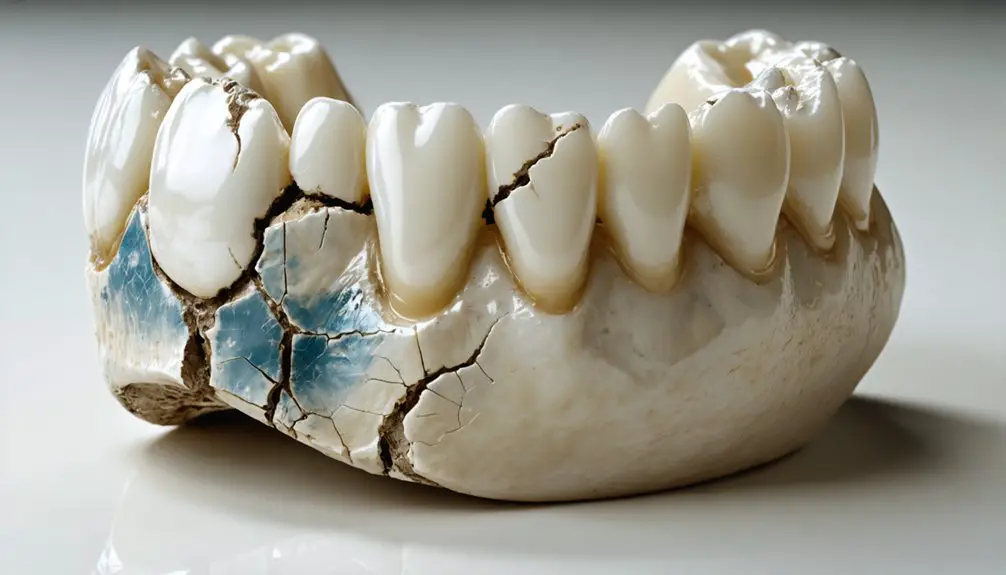
While teeth whitening remains a popular cosmetic procedure, its effects on compromised enamel structure warrant careful consideration. The process can cause temporary enamel softening and reduced microhardness, particularly when using high concentrations of hydrogen peroxide.
You’ll notice these effects are most pronounced within 24 hours of treatment, though they’re generally reversible with proper care and remineralization.
What’s more concerning is the impact on bonding potential. If you’re planning restorative work, whitening can considerably reduce the adhesive strength between enamel and composite materials.
The residual peroxide interferes with resin polymerization, potentially compromising the success of future dental restorations. You’ll need to carefully time any bonding procedures after whitening or consider antioxidant treatments to restore proper adhesion strength.
Heightened Sensitivity Concerns
If you have damaged teeth, you’ll likely experience heightened sensitivity during whitening treatments, with over 50% of patients reporting pain that peaks within 24 hours of application.
Your pre-existing tooth damage can intensify discomfort since compromised enamel and exposed dentin allow whitening agents to penetrate more deeply, leading to increased nerve irritation.
You may need specialized desensitizing treatments and modified whitening protocols to manage both immediate sensitivity during the procedure and any long-term effects that could persist for up to two weeks.
Pain Intensity During Treatment
Patients undergoing teeth whitening procedures on damaged teeth face a significant risk of heightened sensitivity, with over 50% reporting discomfort during treatment.
You’ll find that higher peroxide concentrations (35-40%) intensify pain, particularly in teeth with exposed dentin or cementum due to damage or recession.
For effective pain management and sensitivity reduction, consider that timing is essential. While most patients experience peak discomfort immediately after treatment, the pain typically subsides within 24 hours.
In cases of damaged teeth, you’ll need to monitor the increased vulnerability to sensitivity caused by exposed dentinal tubules, which allow faster peroxide penetration.
The temporary demineralization of enamel during whitening can further intensify pain, especially in compromised teeth, though this usually resolves as the enamel remineralizes.
Managing Long-Term Discomfort Effects
Managing long-term discomfort after whitening damaged teeth requires a strategic approach focused on both prevention and symptom control. Effective sensitivity management starts with understanding your tooth structure’s vulnerability and adjusting treatment protocols accordingly.
You’ll need to implement specific recovery techniques to minimize prolonged discomfort.
Key steps for managing post-whitening sensitivity include:
- Apply desensitizing toothpaste containing potassium nitrate before and after treatments to strengthen enamel protection.
- Reduce whitening frequency and peroxide concentration if you’re experiencing persistent sensitivity.
- Avoid temperature extremes and acidic foods during the recovery period, particularly if symptoms last beyond 72 hours.
For best results, you should use custom-fitted trays to guarantee even application and minimize gum irritation.
If sensitivity persists beyond two weeks, you’ll need professional evaluation to rule out underlying dental issues.
Pre-Existing Sensitivity Complications
Because damaged teeth often exhibit heightened sensitivity to whitening agents, you’ll need to approach treatment with extra caution when pre-existing complications are present.
Common sensitivity triggers include temperature changes and chemical exposure from peroxide bleaching agents, which can penetrate compromised enamel more easily.
Your patients with exposed dentin or cementum face heightened risks, as whitening agents gain direct access to nerve endings.
For effective discomfort management, consider using products with lower peroxide concentrations (around 10%) and incorporating desensitizing agents like fluoride or potassium nitrate.
Be particularly vigilant with patients who already experience tooth sensitivity, as they’re more susceptible to complications.
Watch for signs of gingival irritation or excessive enamel erosion, which can compound sensitivity issues and compromise treatment outcomes.
Treatment Limitations and Restrictions
While teeth whitening can effectively brighten smiles, significant limitations and restrictions apply when treating damaged teeth.
Treatment effectiveness and enamel preservation require careful consideration of your tooth condition before proceeding with any whitening procedure.
Your dentist will need to assess these key restrictions:
- Existing damage or decay must be treated before whitening to prevent worsening structural problems.
- Custom-fitted trays and supervised treatments are essential for protecting compromised teeth.
- Recovery periods between treatments are necessary to allow proper enamel remineralization.
You’ll need to limit whitening frequency to once or twice yearly, particularly if you have sensitive teeth or thin enamel.
Professional monitoring helps guarantee treatments don’t exceed safe concentrations and durations, protecting your dental health while achieving desired results.
Safe Alternatives for Damaged Teeth
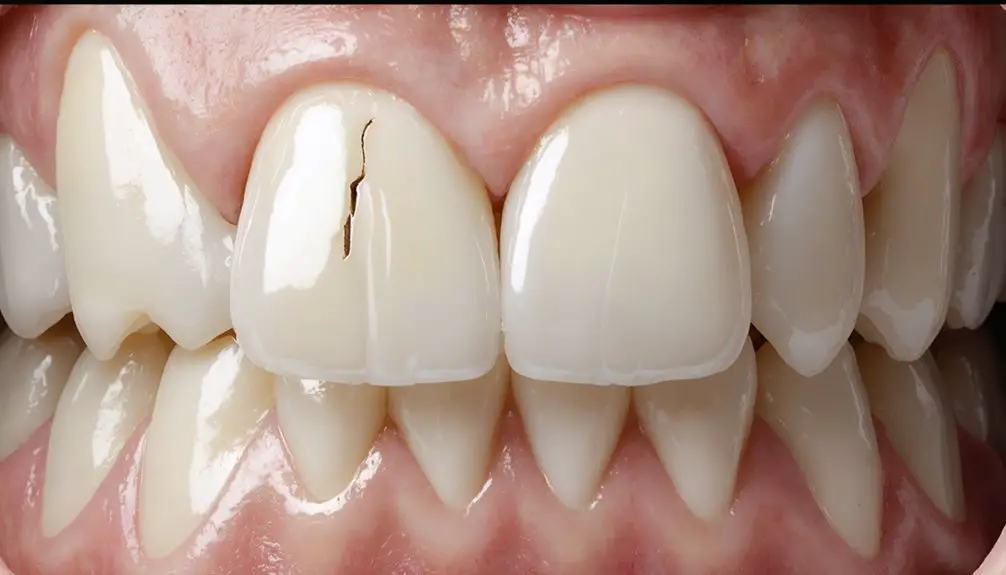
For those with damaged teeth, several safe whitening alternatives can help achieve a brighter smile without compromising dental health.
Professional treatments under dental supervision offer the most controlled approach to gentle whitening, using custom-fitted trays and carefully monitored peroxide concentrations.
You’ll find ADA-approved whitening toothpastes with mild abrasives provide a safer daily option for enamel care, particularly when they contain non-peroxide ingredients.
To maintain results while protecting vulnerable teeth, you can adopt preventive behaviors like using a straw for staining beverages and maintaining thorough oral hygiene.
While natural remedies like strawberries or activated charcoal may seem appealing, you should use these sparingly and only after consulting your dentist, as they can potentially affect enamel integrity.
Prevention and Protective Measures
Taking proactive steps to protect damaged teeth during whitening considerably reduces health risks and improves treatment outcomes. Following essential whitening precautions and prioritizing enamel protection will help safeguard your dental health during the process.
- Schedule a professional consultation before starting any whitening treatment to assess your tooth condition and receive a customized treatment plan that addresses your specific needs.
- Use custom-fitted whitening trays provided by your dentist to guarantee precise application and minimize contact with sensitive gum tissue.
- Select ADA-approved whitening products specifically designed for compromised teeth, and strictly follow application instructions to prevent overexposure.
Remember to maintain gentle oral hygiene practices during treatment, using soft-bristled brushes and avoiding abrasive products.
If you experience sensitivity or irritation, reduce treatment frequency or consult your dentist immediately.
Frequently Asked Questions
Can Teeth Whitening Cause Permanent Nerve Damage in Already Compromised Teeth?
You’ll rarely experience permanent nerve damage from whitening ingredients, but compromised teeth have higher risks. Consult your dentist first, as pre-existing damage can increase nerve sensitivity and complications.
How Long Should I Wait After Dental Work Before Pursuing Whitening Treatment?
While sensitivity varies between procedures, you’ll need to wait 1-2 weeks for fillings, 2-4 weeks for crowns, 3-4 weeks post-root canal, and 6-8 weeks after extractions before pursuing teeth whitening.
Will Whitening Make Existing Hairline Cracks in Teeth More Noticeable?
Yes, whitening can make existing hairline cracks more visible since it increases your tooth enamel’s translucency. While this may raise cosmetic concerns, these cracks aren’t new or structurally threatening.
Does Whitening Affect the Durability of Temporary Dental Cement or Bonds?
You’ll want to exercise caution as whitening can considerably compromise temporary cement effects and bond integrity. Your dental work’s durability may decrease if you whiten within 24 hours of placement.
Can Whitening Treatments Reactivate Old Root Canal Infections or Complications?
You’ll face increased infection risks when whitening techniques interact with root canal-treated teeth, as bleaching agents can penetrate compromised seals and reactivate dormant bacteria in incompletely cleaned canals.
References
- https://www.eastridgedentalgreenbay.com/teeth-whitening-cause-enamel-loss/
- https://health.clevelandclinic.org/is-teeth-whitening-safe
- https://www.dentistryofwestbend.com/teeth-whitening-risks-and-side-effects/
- https://111dental.com/can-teeth-whitening-damage-gums-how-to-whiten-safely-in-bixby-ok/
- https://www.glendaleheightsfamilydental.com/blogs/diy-teeth-whitening-risks
- https://www.ncbi.nlm.nih.gov/books/NBK8259/
- https://newsroom.cigna.com/medical-conditions-with-surprising-connection-oral-health
- https://blyssdental.com/top-15-common-dental-problems/
- https://www.makowskidental.com/blog/what-you-may-not-know-about-dental-emergencies
- https://my.clevelandclinic.org/health/diseases/21482-gum-periodontal-disease
